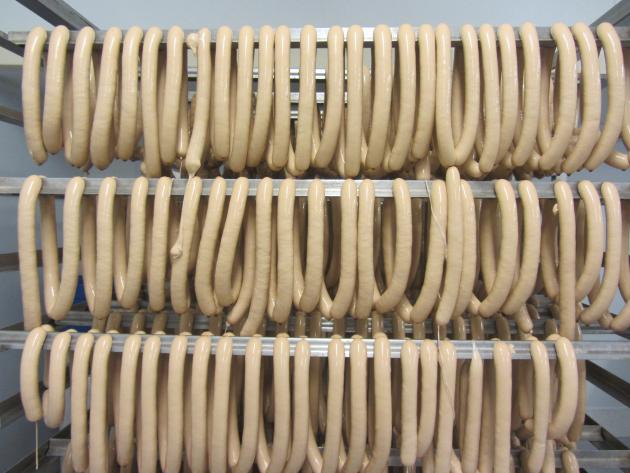Increase Your Retail Sales with More Frequent Delivery
Nick McCann, Iowa State University Extension
Nick McCann is an Agricultural Business Specialist with Iowa State University Cooperative Extension. He works with small meat plants in Iowa, helping them improve their bottom lines by identifying useful and practical changes they can make in their processes and management.
How can you make more money in wholesale? Many meat processors and farmers sell their meat products to retail stores, on a wholesale basis. The retailer pays the processor or farmer for the product and then marks it up for final sale to the customer. If processors and farmers want to make more money on their products, they might try raising the price they charge retailers. But usually the retailer will raise the price to consumers, and sales volume will go down.
In Iowa, we are working with processors and farmers on a new approach to increasing their profitability, by looking more closely at the retail environment.
Stock Outs and Mark Downs: Bad for Business
What we saw is that retailers carrying local meat and cheeses too often are out of stock of those products or forced to mark products down as they get close to expiration. This was a universal problem, but heightened with specialty products and relatively slow movers. These are exactly the types of products most small meat plants sell. If you sell to retailers and they’re out of stock of your product, you’re missing out on sales. And when products are close to their expiration dates, the same thing happens: they won’t sell or they are marked down so much they hurt profitability. Plus, your customer is more likely to get a product not up to snuff, and they may their friends they’re disappointed. Not good.
 Common sense tells us that product must be available when the customer comes into a retail store: customers don’t usually call ahead or place orders. And demand is highly variable. I might sell two cases of a product this week and fifteen the next. So retailers, when they order from you, have to do a lot of guessing about the future. This is especially true if your truck only comes every week or every two weeks, to save on transport costs.
Common sense tells us that product must be available when the customer comes into a retail store: customers don’t usually call ahead or place orders. And demand is highly variable. I might sell two cases of a product this week and fifteen the next. So retailers, when they order from you, have to do a lot of guessing about the future. This is especially true if your truck only comes every week or every two weeks, to save on transport costs.
Solving the Problem with More Frequent Delivery
How to solve this problem? More frequent delivery. We’ve been trying it, with great results. For example, we worked with a small processor who delivers 35 to 40 different items to a retailer. When we started delivering three times a week (instead of once per week) and receiving orders multiple times per week, sales increased 75%. The retailer had better, fresher product on the shelf and wasn’t ever out of stock. Same truck, same people, same operation.
In addition to increasing the frequency of delivery, we also dialed into the POS data at retailers. Most retailers, even small shops with older systems, have a way to automate sales data. I can get an email every morning about what was sold in the last 24 hours.
So we now tell retailers three things: (1) we guarantee product quality, (2) we’ll deliver more frequently, and (3) no minimum purchase required. For those benefits, we increase our price to the retailer, by 25-100%. Yet because the retailer will have more sales and fewer losses (expired product), the price to the end consumer stays the same. And we don’t reduce our sales volume.
When I can track inventory on those retail shelves and deliver frequently and I’m local, I don’t lose any product. There is a small increase in transport costs, but the increase in cash flow and profitability is tremendous.
Smaller Batches, More Often, Really Works
Replenishing shelves three times a week might seem excessive, especially if you still only make the product once a week. We do encourage folks to produce more frequently, in smaller batches.
But here’s the big reason: When my retail customers are forced to look out too far into the future, they tend to over-order or under-order. Retailers with multiple stores often have problems with misallocation: some stores have too much product, some have too little. More frequent ordering and delivery helps retailers – and suppliers – stay closer to true demand. You can maintain a smaller inventory of product at more locations, satisfying more customers more of the time. It also eases introductions of new product lines by minimizing the risk of taking on new products – which helps retailers.
Yes, transportation has a cost, especially as your delivery area grows. If you’re a small producer selling one product to one store and can’t fill a truck, then this may not be a good idea. You could consider pooling delivery with other farmers.
The Bottom Line
Our pilot projects are having a lot of success – improving their cash flow, return on investment, and net income. We are currently scaling up our efforts and will report back when we have new results.
Nick McCann is an Agricultural Business Specialist with Iowa State University Cooperative Extension, based in Decorah, IA. You can reach him at 563-382-2949 or nemccann@iastate.edu.
